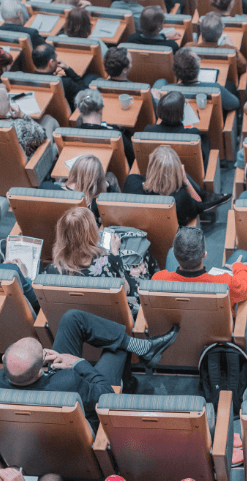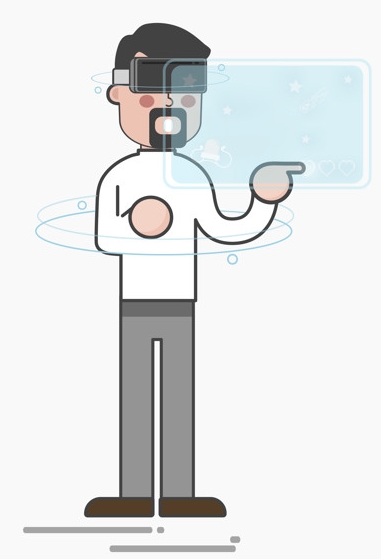E-learning is no longer a new learning and training technique, but rather a transformation digital rather than acquired in the corporate world. It is a full and conscious, necessary and fruitful transformation of the didactic processes. Over time, e-learning has become a common daily use for all people involved in every sector of work and in every role played. The lessons in the classroom, by a teacher expert in the subject have not disappeared, but more and more realities feel the need to digitize this educational process in the increasingly improved forms of teaching and learning.
This is why e-learning platforms have fully entered the lives of many people. If once education-training, work and daily life had clearly separated spaces, now they coexist peacefully together. Information and education have long since left the classrooms of schools and universities to enter companies first, and then also in everyone's daily life. Formation has become permanent and continuous. The commitment to which all the people who work in every sector are called in training are practically daily, and through the most diverse tools that are no longer just computers, but also our own mobile phones, which we can no longer give up not only in our communications and in the social spaces that belong to us, but also, now, in accessing information that is useful and necessary for our activities.

We live in a society that, in its entirety, has become a society of continuous change where each company is itself a large, medium or small company, which produces and promotes the change, from which it is conveyed and of which it is a vehicle, as it happens in all systemic phenomena, in which, in a circular causality, the elements involved are mutually cause and effect between them.
This constantly and rapidly evolving society calls people themselves to paths that are no longer new, but today constant and daily, linked to a need for continuous learning, unlike the epochs that precede us, when education and work had practically separate spaces between them.
Learning is certainly the most valuable ability and skill we have. Within it we find value and meaning in our work and in our daily actions, having, if we know how to respond to the multiple inputs involved, a new identity code, aimed at the continuous growth of the person in all its aspects. This ability of ours possesses an intrinsic value which is related to the active and continuous involvement of people, intelligences, attentions, who interact with each other constantly and allow us to exchange information, ideas, and methods with each other.
This is the natural habitat, full of ideas for development and progress, where e-learning lives and continues to grow. The companies that promoted and supported e-learning training, also being able to monitor the training process, obtained largely positive results in terms of efficiency and competitiveness.
Nothing comes from chance in the training development process, and a new training system corresponds to a new language that is enriched day by day with new tools and methodologies, aimed at the needs of the people who will take advantage of the courses.
It has been said elsewhere that an intelligent world calls for intelligent e-learning, and that's what's going on.
Strada has made a lot of it and a lot more will be done from the first forms of distance training that we remember, since the path has long been started and nothing suggests that it can stop. The mastery of content is an acquired fact and is linked to the considerable experience of the companies that have been dealing with the educational process for more than twenty years.
There are many forms of interaction possible today between disciples and teachers or classroom tutors, or between the disciples themselves, to the point of significantly reducing the rarefaction of communication and of the relationship that certainly afflicted distance learning at its birth. Human interaction with teachers / tutors and with other students makes it possible and promotes, through the communication technologies on the net, the creation of collective learning contexts, in which learning itself is richer and more effective, in terms of contents, reports, and assumptions to be addressed and verified.

Many and ever more effective are the tools used by the teacher-designer who works in the realization of individual courses, educational projects, from direct dialogue, to images, videos, audio and access to infinite forms of the web, generating educational material not only clear but also effective and pleasant to use, forgetting the initial diffidence and difficulties, which now remain only rare and residual elements. The improvement of communication techniques and the use of different devices and of daily use have ended up making the use of courses more and more satisfactory, not so much or only for companies, which can better and directly monitor the process, but also and especially for end users who find an educational project increasingly targeted to their personal needs effective and pleasant to use.
If we want to observe the development trends along which the web itself is heading, it has no difficulty in suggesting it:

Social learning. The concept of social learning is suggested by the studies of the Canadian psychologist-trainer Albert Bandura. According to the author, mutual interaction with each other is at the source of our learning and acquisition systems from birth, but also in later ages. nihil novi sub sole. There is nothing new in human experience. Plato already stated twenty-five centuries ago that human learning does not take place except through ta erotikà, the laws of love. That is, we learn only through imitation, participation and above all fascination. There must be within the educational process and for it to be effective collaboration and sharing of the training contents, and this can only be achieved through the expansion, already mentioned previously, of the interactions between disciples and teachers, and between the disciples themselves, in a way to encourage, support and develop communications through network technologies. The need for the other is an essential component of our interactions in real life and in the work we do. Only through a targeted management of contents and an equally careful attention to the relational aspects of didactic communication, relationships based on mutual fascination, as a substantial learning vehicle, can arise vertically and horizontally.

Mobile learning. The use of the training content (learning object) today takes place not in the most different moments of the day, according to the needs of the users, but also through the most disparate tools in relation to the familiarity of use and availability of them, without being decreased chances of acquisition. If anything, the latter have increased and increasingly easier to access. There is more and more talk of just in time and just for me acquisitions, which may vary in the size of the formats, but are in any case always conceived and implemented according to the different needs of users.

Adaptive learning. In the last few years, the field of intervention in training planning has shifted to personalized training, capable of understanding and directing more and more towards tailor-made, or tailor-made, teaching, in relation to the needs of those who benefit from it. This is also one of the areas in which much work has been done and much is believed to be done for ever greater effectiveness in teaching and learning.
Microlearning. Training sectors have been identified in which this didactic form has proven to be highly effective, where the need for short and targeted contents is accompanied by the possibility of use at the most different times of the day, always in relation to the needs of the user. What first appeared as a form of 'hit and run' learning proved to be extremely effective and even enjoyable to use. Each new training sector does not exclude others at all, but is added to them, finding for itself the space it needs and where it proves its effectiveness.

Augmented reality. We have been in the era of video information for about seventy years and we can see things that happen in other parts of the world from home in real time. What is normal today only a few years before was absolutely unthinkable. Video communication has become almost total and, necessarily, it also affects the world of education closely by using communication channels rich in images, audio, video, links to the web, building an extraordinarily powerful and effective teaching material. The initial impact with such a rich communication and training method was also disconcerting for many of us, but today we ended up becoming familiar with a communicative-training method that no one can do without.

Learning Analytics. This last didactic-training research factor analyzes data and information to perform a classification of user preferences related to personalized learning programs. By verifying individual preferences, the customization of courses is further improved according to the characteristics of the end user, as previously indicated.
So a long way, it has already been said, has been done and much more will be done in a sector that is now part of our daily lives. The directions to be taken have been traced, and many ways open others, since in the educational research each job creates new intuitions and new ways to go.
Article written by Claudius del Conte